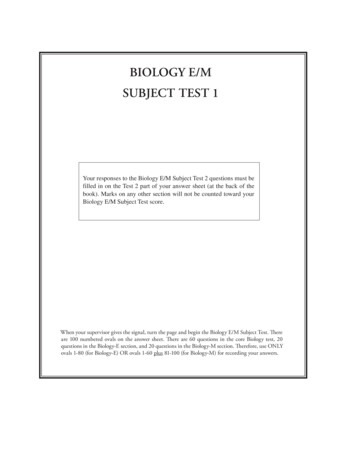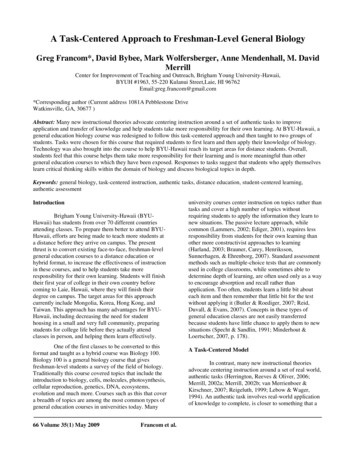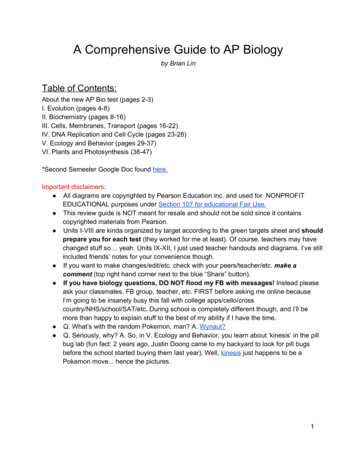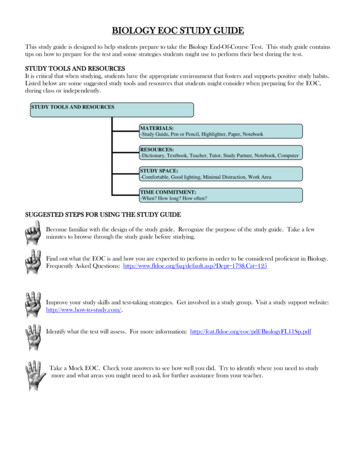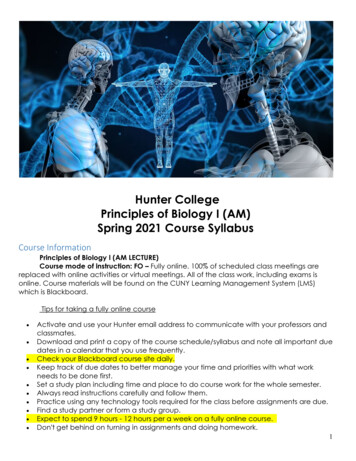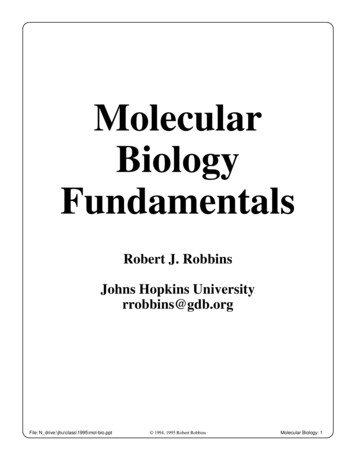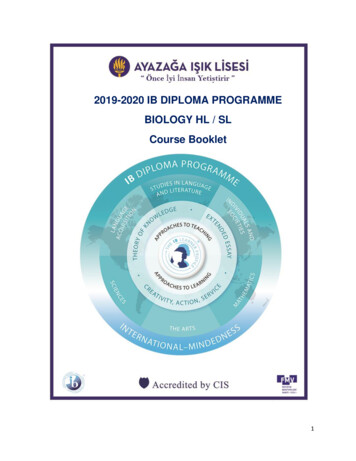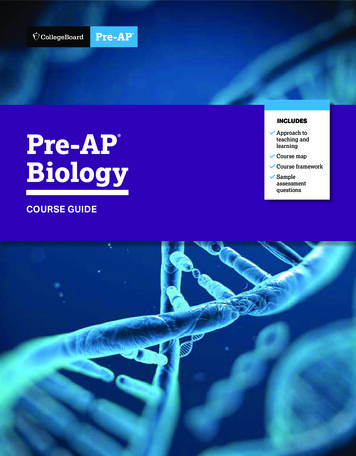
Transcription
INCLUDESPre-APBiology COURSE GUIDEApproach toteaching andlearningCourse mapCourse frameworkSampleassessmentquestions
Pre-APBiology COURSE GUIDEUpdated Fall 2020Please visit Pre-AP online at preap.collegeboard.org for more information and updates aboutthe course and program features.
ABOUT COLLEGE BOARDCollege Board is a mission-driven not-for-profit organization that connects students to collegesuccess and opportunity. Founded in 1900, College Board was created to expand accessto higher education. Today, the membership association is made up of over 6,000 of theworld’s leading educational institutions and is dedicated to promoting excellence and equityin education. Each year, College Board helps more than seven million students prepare fora successful transition to college through programs and services in college readiness andcollege success—including the SAT and the Advanced Placement Program . The organizationalso serves the education community through research and advocacy on behalf of students,educators, and schools.For further information, visit www.collegeboard.org.PRE-AP EQUITY AND ACCESS POLICYCollege Board believes that all students deserve engaging, relevant, and challenging gradelevel coursework. Access to this type of coursework increases opportunities for all students,including groups that have been traditionally underrepresented in AP and college classrooms.Therefore, the Pre-AP program is dedicated to collaborating with educators across the countryto ensure all students have the supports to succeed in appropriately challenging classroomexperiences that allow students to learn and grow. It is only through a sustained commitment toequitable preparation, access, and support that true excellence can be achieved for all students,and the Pre-AP course designation requires this commitment.ISBN: 978-1-4573-1513-8 2021 College Board. PSAT/NMSQT is a registered trademark of the College Board and National MeritScholarship Corporation.1 2 3 4 5 6 7 8 9 10
ContentsvAcknowledgmentsABOUT PRE-AP33Introduction to Pre-APDeveloping the Pre-AP Courses4How to Get Involved3Pre-AP Educator Network55Pre-AP Approach to Teaching and LearningFocused Content8Targeted Assessments for Learning59Horizontally and Vertically Aligned InstructionPre-AP Professional LearningABOUT PRE-AP BIOLOGY1313Introduction to Pre-AP BiologyPre-AP Science Areas of Focus16Summary of Resources and Supports1518Pre-AP Biology and Career ReadinessCourse Map2020Pre-AP Biology Course FrameworkIntroduction22Big Ideas in Pre-AP Biology212324313544Course Framework ComponentsOverview of Pre-AP Biology Units and Enduring UnderstandingsUnit 1: Ecological SystemsUnit 2: EvolutionUnit 3: Cellular SystemsUnit 4: Genetics5253Pre-AP Biology Model LessonsSupport Features in Model Lessons5454Pre-AP Biology Assessments for LearningLearning Checkpoints58Sample Performance Task and Scoring Guidelines5664667173Performance TasksFinal ExamSample Assessment QuestionsPre-AP Biology Course DesignationAccessing the Digital Materials
AcknowledgmentsCollege Board would like to acknowledge the following committee members, consultants, andreviewers for their assistance with and commitment to the development of this course. Allindividuals and their affiliations were current at the time of contribution.Jason Crean, Lyons Township High School, Lagrange, ILRick Duschl, Penn State University, University Park, PAMark Eberhard, St. Clair High School, St. Clair, MIAmy Fassler, Marshfield High School, Marshfield, WIDavid Hong, Diamond Bar High School, Diamond Bar, CAKenneth Huff, Mill Middle School, Williamsville, ILMichelle Koehler, Riverside Brookfield High School, Riverside, ILCourtney Mayer, Northside Independent School District, San Antonio, TXElisa McCracken, Brandeis High School, San Antonio, TXJennifer Pfannerstill, North Shore Country Day School, Winnetka, ILNancy Ramos, Northside Health Careers High School, San Antonio, TXJim Smanik, Sycamore High, Cincinnati, OHKeri Shingleton, Holland Hall, Tulsa, OKCOLLEGE BOARD STAFFKaren Lionberger, Senior Director, Pre-AP STEM Curriculum, Instruction, and AssessmentBeth Hart, Senior Director, Pre-AP AssessmentMitch Price, Director, Pre-AP STEM AssessmentNatasha Vasavada, Executive Director, Pre-AP Curriculum, Instruction, and Assessment
About Pre-AP
About Pre-APIntroduction to Pre-APEvery student deserves classroom opportunities to learn, grow, and succeed. CollegeBoard developed Pre-AP to deliver on this simple premise. Pre-AP courses aredesigned to support all students across varying levels of readiness. They are not honorsor advanced courses.Participation in Pre-AP courses allows students to slow down and focus on the mostessential and relevant concepts and skills. Students have frequent opportunitiesto engage deeply with texts, sources, and data as well as compelling higher-orderquestions and problems. Across Pre-AP courses, students experience sharedinstructional practices and routines that help them develop and strengthen theimportant critical thinking skills they will need to employ in high school, college, andlife. Students and teachers can see progress and opportunities for growth throughvaried classroom assessments that provide clear and meaningful feedback at keycheckpoints throughout each course.DEVELOPING THE PRE-AP COURSESPre-AP courses are carefully developed in partnership with experienced educators,including middle school, high school, and college faculty. Pre-AP educator committeeswork closely with College Board to ensure that the course resources define, illustrate,and measure grade-level-appropriate learning in a clear, accessible, and engaging way.College Board also gathers feedback from a variety of stakeholders, including Pre-APpartner schools from across the nation who have participated in multiyear pilots ofselect courses. Data and feedback from partner schools, educator committees, andadvisory panels are carefully considered to ensure that Pre-AP courses provide allstudents with grade-level-appropriate learning experiences that place them on a path tocollege and career readiness.PRE-AP EDUCATOR NETWORKSimilar to the way in which teachers of Advanced Placement (AP ) courses canbecome more deeply involved in the program by becoming AP Readers or workshopconsultants, Pre-AP teachers also have opportunities to become active in theireducator network. Each year, College Board expands and strengthens the Pre-APNational Faculty—the team of educators who facilitate Pre-AP Readiness Workshopsand Pre-AP Summer Institutes. Pre-AP teachers can also become curriculum andassessment contributors by working with College Board to design, review, or pilot thecourse resources.Course Guide 2021 College Board3Pre-AP Biology
About Pre-APIntroduction to Pre-APHOW TO GET INVOLVEDSchools and districts interested in learning more about participating in Pre-AP shouldvisit preap.collegeboard.org/join or contact us at preap@collegeboard.org.Teachers interested in becoming members of Pre-AP National Faculty or participatingin content development should visit preap.collegeboard.org/national-faculty orcontact us at preap@collegeboard.org.Pre-AP Biology4Course Guide 2021 College Board
About Pre-APPre-AP Approach to Teaching and LearningPre-AP courses invite all students to learn, grow, and succeed through focused content,horizontally and vertically aligned instruction, and targeted assessments for learning.The Pre-AP approach to teaching and learning, as described below, is not overlycomplex, yet the combined strength results in powerful and lasting benefits for bothteachers and students. This is our theory of action.Horizontally andVertically AlignedInstructionShared Principles,Areas of FocusFocused ContentCourse Frameworks,Model LessonsTargeted Assessmentsand FeedbackLearning Checkpoints,Performance Tasks,Final ExamFOCUSED CONTENTPre-AP courses focus deeply on a limited number of concepts and skills with thebroadest relevance for high school coursework and college and career success. Thecourse framework serves as the foundation of the course and defines these prioritizedconcepts and skills. Pre-AP model lessons and assessments are based directly on thisfocused framework. The course design provides students and teachers with intentionalpermission to slow down and focus.HORIZONTALLY AND VERTICALLY ALIGNED INSTRUCTIONShared principles cut across all Pre-AP courses and disciplines. Each course is alsoaligned to discipline-specific areas of focus that prioritize the critical reasoning skillsand practices central to that discipline.Course Guide 2021 College Board5Pre-AP Biology
About Pre-APPre-AP Approach to Teaching and LearningSHARED PRINCIPLESAll Pre-AP courses share the following set of research-supported instructionalprinciples. Classrooms that regularly focus on these cross-disciplinary principles allowstudents to effectively extend their content knowledge while strengthening their criticalthinking skills. When students are enrolled in multiple Pre-AP courses, the horizontalalignment of the shared principles provides students and teachers across disciplineswith a shared language for their learning and investigation and multiple opportunitiesto practice and grow. The critical reasoning and problem-solving tools studentsdevelop through these shared principles are highly valued in college coursework and inthe workplace.Close Observationand ngSHAREDPRINCIPLESAcademicConversationClose Observation and AnalysisStudents are provided time to carefully observe one data set, text, image, performancepiece, or problem before being asked to explain, analyze, or evaluate. This creates a safeentry point to simply express what they notice and what they wonder. It also encouragesstudents to slow down and capture relevant details with intentionality to support moremeaningful analysis, rather than rushing to completion at the expense of understanding.Higher-Order QuestioningStudents engage with questions designed to encourage thinking that is elevatedbeyond simple memorization and recall. Higher-order questions require students tomake predictions, synthesize, evaluate, and compare. As students grapple with thesequestions, they learn that being inquisitive promotes extended thinking and leads todeeper understanding.Pre-AP Biology6Course Guide 2021 College Board
About Pre-APPre-AP Approach to Teaching and LearningEvidence-Based WritingWith strategic support, students frequently engage in writing coherent argumentsfrom relevant and valid sources of evidence. Pre-AP courses embrace a purposefuland scaffolded approach to writing that begins with a focus on precise and effectivesentences before progressing to longer forms of writing.Academic ConversationThrough peer-to-peer dialogue, students’ ideas are explored, challenged, and refined.As students engage in academic conversation, they come to see the value in beingopen to new ideas and modifying their own ideas based on new information. Studentsgrow as they frequently practice this type of respectful dialogue and critique and learnto recognize that all voices, including their own, deserve to be heard.AREAS OF FOCUSSocial StudiesScienceMathematicsArtsEnglishThe areas of focus are discipline-specific reasoning skills that students developand leverage as they engage with content. Whereas the shared principles promotehorizontal alignment across disciplines, the areas of focus provide vertical alignmentwithin a discipline, giving students the opportunity to strengthen and deepen theirwork with these skills in subsequent courses in the same discipline.Areas of FocusAlign Vertically Within Disciplines(Grades 6-12)Academic ConversationHigher-Order QuestioningEvidence-Based WritingClose Observation and AnalysisShared PrinciplesAlign Horizontally Across All CoursesFor information about the Pre-AP science areas of focus, see page 13.Course Guide 2021 College Board7Pre-AP Biology
About Pre-APPre-AP Approach to Teaching and LearningTARGETED ASSESSMENTS FOR LEARNINGPre-AP courses include strategically designed classroom assessments that serve astools for understanding progress and identifying areas that need more support. Theassessments provide frequent and meaningful feedback for both teachers and studentsacross each unit of the course and for the course as a whole. For more informationabout assessments in Pre-AP Biology, see page 54.Pre-AP Biology8Course Guide 2021 College Board
About Pre-APPre-AP Professional LearningThe summer before their first year teaching a Pre-AP course, teachers are requiredto engage in professional learning offered by College Board. There are two optionsto meet this requirement: the Pre-AP Summer Institute (Pre-APSI) and the OnlineFoundational Module Series. Both options provide continuing education units toeducators who complete the training. The Pre-AP Summer Institute is a four-day collaborative experience that empowersparticipants to prepare and plan for their Pre-AP course. While attending, teachersengage with Pre-AP course frameworks, shared principles, areas of focus, andsample model lessons. Participants are given supportive planning time where theywork with peers to begin to build their Pre-AP course plan. The Online Foundational Module Series will be available beginning July 2020 toall teachers of Pre-AP courses. These 12- to 20-hour courses will support teachersin preparing for their Pre-AP course. Teachers will explore course materials andexperience model lessons from the student’s point of view. They will also beginto plan and build their own course materials, so they are ready on day one ofinstruction.Pre-AP teachers also have access to the Online Performance Task Scoring Modules,which offer guidance and practice applying Pre-AP scoring guidelines to student work.Course Guide 2021 College Board9Pre-AP Biology
About Pre-APBiology
About Pre-AP BiologyIntroduction to Pre-AP BiologyThe Pre-AP Biology course emphasizes the integration of content with sciencepractices—powerful reasoning tools that support students in analyzing the naturalworld around them. Having this ability is one of the hallmarks of scientific literacy andis critical for numerous college and career endeavors in science and the social sciences.Rather than seeking to cover all topics traditionally included in a standard biologytextbook, this course focuses on the foundational biology knowledge and skills thatmatter most for college and career readiness. The Pre-AP Biology Course Frameworkhighlights how to guide students to connect core ideas within and across the unitsof the course, promoting the development of a coherent understanding of biologicalsystems.The components of this course have been crafted to prepare not only the nextgeneration of biologists but also a broader base of biology-informed citizens who arewell equipped to respond to the array of science-related issues that impact our lives atthe personal, local, and global levels.PRE-AP SCIENCE AREAS OF FOCUSThe Pre-AP science areas of focus, shown below, are science practices that studentsdevelop and leverage as they engage with content. They were identified througheducator feedback and research about where students and teachers need the mostcurriculum support. These areas of focus are vertically aligned to the science practicesembedded in other science courses in high school, including AP, and in college, givingstudents multiple opportunities to strengthen and deepen their work with these skillsthroughout their educational career. They also support and align to the NGSS and APscience practices of theory building and refinement.Strategic UseofMathematicsEmphasison AnalyticalReading andScienceWritingAreas of FocusCourse Guide 2021 College Board13AttentiontoModelingPre-AP Biology
About Pre-AP BiologyIntroduction to Pre-AP BiologyEmphasis on Analytical Reading and WritingStudents engage in analytical reading and writing to gain, retain, and applyscientific knowledge and to carry out scientific argumentation.In prioritizing analytical reading, Pre-AP Biology classrooms ask students to extract,synthesize, and compare complex information, often by moving between texts andmultiple representations, such as tables and graphs. Through analytical writing activities,Pre-AP Biology students must integrate and translate that information to generatescientific questions, design methods for answering questions, and develop scientificarguments. Moreover, the application of these skills to the understanding of informalscience texts, such as articles found in newspapers, online sources, and magazines,prepares students to be discerning consumers of scientific information.Strategic Use of MathematicsStudents use mathematics strategically in order to understand and express thequantitative aspects of biology, to record and interpret experimental data, and tosolve problems as they arise.The ability to analyze and interpret data collected while investigating the natural worldis a critical practice for scientists. Once collected, data must be translated into formsthat can be analyzed in an attempt to reveal meaningful patterns and relationships.These patterns and relationships are not always immediately obvious, so students mustbecome strategic in how they choose to apply mathematical and statistical thinking inorder to analyze data.Attention to ModelingStudents go beyond labeling diagrams to creating, revising, and using models toexplain key patterns, interactions, and relationships in biological systems.Modeling is a core practice for scientists as they use a variety of models to develop,refine, and communicate their ideas about the natural world. Engaging students inmodeling also reinforces other scientific reasoning skills, such as data analysis andscientific argumentation. Modeling also helps illustrate for students how scientificknowledge is constructed and modified over time as new data and evidence emergeand models are revised based on this new information.Pre-AP Biology14Course Guide 2021 College Board
About Pre-AP BiologyIntroduction to Pre-AP BiologyPRE-AP BIOLOGY AND CAREER READINESSThe Pre-AP Biology course resources are designed to expose students to a wide rangeof career opportunities that depend on biology knowledge and skills. Examples includenot only careers within the life sciences, such as marine ecologist or wildlife geneticist,but also other endeavors where biology knowledge is relevant, such as the work of apark ranger or healthcare policymaker.Career clusters that involve biology, along with examples of careers in biology orrelated to biology, are provided below. Teachers should consider discussing these withstudents throughout the year to promote motivation and engagement.Career Clusters Involving Biologyagriculture, food, and natural resourceshealthcare and health sciencehuman servicesmanufacturingSTEM (science, technology, engineering, and math)Examples of Biology CareersExamples of Biology Related Careersbiology teacher/professorbotanistecologistgenetic counselormarine biologistmicrobiologistneurologistprimary care mistdental assistant/dentistenvironmental scientistforensic scientistmedical assistantnursepharmacistphysician assistantscience writerSource for Career Clusters: “Advanced Placement and Career and Technical Education: Working Together.”Advance CTE and the College Board. October 2018. ther.For more information about careers that involve biology, teachers and students canvisit and explore the College Board’s Big Future urse Guide 2021 College Board15Pre-AP Biology
About Pre-AP BiologyIntroduction to Pre-AP BiologySUMMARY OF RESOURCES AND SUPPORTSTeachers are strongly encouraged to take advantage of the full set of resources andsupports for Pre-AP Biology, which is summarized below. Some of these resourcesmust be used for a course to receive the Pre-AP Course Designation. To learn moreabout the requirements for course designation, see details below and on page 71.COURSE FRAMEWORKIncluded in this guide as well as in the Pre-AP Biology Teacher Resources, theframework defines what students should know and be able to do by the end of thecourse. It serves as an anchor for model lessons and assessments, and it is the primarydocument teachers can use to align instruction to course content. Use of the courseframework is required. For more details see page 20.MODEL LESSONSTeacher resources, available in print and online, include a robust set of model lessonsthat demonstrate how to translate the course framework, shared principles, and areas offocus into daily instruction. Use of the model lessons is encouraged but not required.For more details see page 52.LEARNING CHECKPOINTSAccessed through Pre-AP Classroom (the Pre-AP digital platform), these shortformative assessments provide insight into student progress. They are automaticallyscored and include multiple-choice and technology-enhanced items with rationalesthat explain correct and incorrect answers. Use of one learning checkpoint per unit isrequired. For more details see page 54.PERFORMANCE TASKSAvailable in the printed teacher resources as well as on Pre-AP Classroom,performance tasks allow students to demonstrate their learning through extendedproblem-solving, writing, analysis, and/or reasoning tasks. Scoring guidelines areprovided to inform teacher scoring, with additional practice and feedback suggestionsavailable in online modules on Pre-AP Classroom. Use of each unit’s performancetask is required. For more details see page 56.PRACTICE PERFORMANCE TASKSAvailable in the student resources, with supporting materials in the teacher resources,these tasks provide an opportunity for students to practice applying skills andknowledge as they would in a performance task, but in a more scaffolded environment.Use of the practice performance tasks is encouraged but not required. For moredetails see page 57.Pre-AP Biology16Course Guide 2021 College Board
About Pre-AP BiologyIntroduction to Pre-AP BiologyFINAL EXAMAccessed through Pre-AP Classroom, the final exam serves as a classroom-based,summative assessment designed to measure students’ success in learning and applyingthe knowledge and skills articulated in the course framework. Administration of thefinal exam is encouraged but not required. For more details see page 64.PROFESSIONAL LEARNINGBoth the four-day Pre-AP Summer Institute (Pre-APSI) and the Online FoundationalModule Series support teachers in preparing and planning to teach their Pre-APcourse. All Pre-AP teachers are required to either attend the Pre-AP SummerInstitute or complete the module series. In addition, teachers are required tocomplete at least one Online Performance Task Scoring module. For more details seepage 9.Course Guide 2021 College Board17Pre-AP Biology
UNIT 1Course MapEcologicalSystems 25 Class PeriodsPre-AP model lessons provided forapproximately 70% of instructionaltime in this unitPLANThe course map shows how components are positioned throughoutthe course. As the map indicates, the course is designed to be taughtover 140 class periods (based on 45-minute class periods), for a totalof 28 weeks.KEY CONCEPT ECO 1Cycling of Matter in the BiosphereModel lessons are included for approximately 50% of the totalinstructional time, with the percentage varying by unit. Each unit isdivided into key concepts.Population DynamicsTEACHLearning Checkpoint 1The model lessons demonstrate how the Pre-AP shared principlesand science areas of focus come to life in the classroom.Shared PrinciplesClose observation and analysisHigher-order questioningEvidence-based writingAcademic conversationKEY CONCEPT ECO 2KEY CONCEPT ECO 3Defining Ecological CommunitiesKEY CONCEPT ECO 4Ecological Community DynamicsScience Areas of FocusEmphasis on analytical reading and writingStrategic use of mathematicsAttention to modelingKEY CONCEPT ECO 5Changes in Ecological CommunitiesASSESS AND REFLECTEach unit includes two learning checkpoints and a performance task.These formative assessments are designed to provide meaningfulfeedback for both teachers and students. Opportunities for formativeassessment are also provided throughout the model lessons.Learning Checkpoint 2Performance Task for Unit 1Note: The final exam, offered during a six-week window in the spring,is not represented in the map.Pre-AP Biology18Course Guide 2021 College Board
UNIT 2Evolution 20 Class PeriodsPre-AP model lessons provided forapproximately 40% of instructionaltime in this unitUNIT 3Cellular Systems 50 Class PeriodsPre-AP model lessons provided forapproximately 40% of instructionaltime in this unitUNIT 4Genetics 45 Class PeriodsPre-AP model lessons provided forapproximately 35% of instructionaltime in this unitKEY CONCEPT EVO 1KEY CONCEPT CELLS 1KEY CONCEPT GEN 1Patterns of EvolutionChemistry of LifeStructure of DNAKEY CONCEPT EVO 2KEY CONCEPT CELLS 2KEY CONCEPT GEN 2Mechanisms of EvolutionCell Structure and FunctionDNA SynthesisLearning Checkpoint 1KEY CONCEPT CELLS 3KEY CONCEPT GEN 3Cell Transport and HomeostasisProtein SynthesisKEY CONCEPT CELLS 4Learning Checkpoint 1KEY CONCEPT EVO 3SpeciationLearning Checkpoint 2Performance Task for Unit 2Organisms Maintaining HomeostasisLearning Checkpoint 1KEY CONCEPT GEN 4Asexual and Sexual Passing of TraitsKEY CONCEPT CELLS 5KEY CONCEPT GEN 5Cell Growth and DivisionInheritance PatternsKEY CONCEPT CELLS 6KEY CONCEPT GEN 6PhotosynthesisBiotechnologyKEY CONCEPT CELLS 7Learning Checkpoint 2Cellular Respiration andFermentationPerformance Task for Unit 4Learning Checkpoint 2Performance Task for Unit 3Course Guide 2021 College Board19Pre-AP Biology
About Pre-AP BiologyPre-AP Biology Course FrameworkINTRODUCTIONBased on the Understanding by Design (Wiggins and McTighe) model, the Pre-APBiology Course Framework is back mapped from AP expectations and aligned toessential grade-level expectations. The course framework serves as a teacher’s blueprintfor the Pre-AP Biology instructional resources and assessments.The course framework was designed to meet the following criteria: Focused: The framework provides a deep focus on a limited number of conceptsand skills that have the broadest relevance for later high school, college, and careersuccess. Measurable: The framework’s learning objectives are observable and measurablestatements about the knowledge and skills students should develop in the course. Manageable: The framework is manageable for a full year of instruction, fostersthe ability to explore concepts in depth, and enables room for additional local orstate standards to be addressed where appropriate. Accessible: The framework’s learning objectives are designed to provide allstudents, across varying levels of readiness, with opportunities to learn, grow, andsucceed.Pre-AP Biology20Course Guide 2021 College Board
About Pre-AP BiologyPre-AP Biology Course FrameworkCOURSE FRAMEWORK COMPONENTSThe Pre-AP Biology Course Framework includes the following components:Big IdeasThe big ideas are recurring themes that allow students to create meaningfulconnections between course concepts. Revisiting the big ideas throughout thecourse and applying them in a variety of contexts allows students to develop deeperconceptual understandings.Enduring UnderstandingsEach unit focuses on a small set of enduring understandings. These are the long-termtakeaways related to the big ideas that leave a lasting impression on students. Studentsbuild and earn these understandings over time by exploring and applying coursecontent throughout the year.Key ConceptsTo support teacher planning and instruction, each unit is organized by key concepts.Each key concept includes relevant learning objectives and essential knowledgestatements and may also include content boundary and cross connection statements.These are illustrated and defined below.Essential KnowledgeStatements:About Pre-AP BiologyThe essential knowledgestatements are linked to oneor more learning objectives.These statements describe theknowledge required to performthe learning objective(s).Pre-AP Biology Course FrameworkLearning Objectives:These objectives definewhat a student needsto be able to do withessential knowledgein order to progresstoward the enduringunderstandings. Thelearning objectivesserve as actionabletargets for instructionand assessments.KEY CONCEPT EVO 1: PATTERNS OF EVOLUTIONLearning ObjectivesStudents will be able to Essential KnowledgeStudents need to know that Theory of EvolutionEVO 1.1(a) Use scientific evidence to justify a claim ofan evolutionary relationship between species.EVO 1.1(b) Describe shared characteristics(homologies) among organisms that provide evidencefor common ancestry.EVO 1.1.1 The theory of evolution states that the unity anddiversity of life we see today is the result of more than 3.5billion years of evolutionary processes on Earth.EVO 1.1.2 Scientists use various sources of evidence toestablish evolutionary relationships between organisms.a. Fossil evidence, in conjunction with relative and radiometricdating, provides insight into the geographic and temporaldistribution of species throughout Earth’s history.b. Comparisons of anatomical and molecular homologies areused to determine the degree of divergence from a commonancestor.1. The structure and function of DNA is a homology thatlinks all living organisms across the three domains oflife—Archaea, Bacteria, and Eukarya.2. Cellular structures across all living organisms arestrikingly similar.Classifying Evolutionary RelationshipsEVO 1.2(a) Create or use models to illustrateevolutionary relationships.EVO 1.2(b) Use models of evolutionary relationshipsto describe and/or analyze how different species arerelated.EVO 1.2.1 Ev
Pre-AP Biology COURSE GUIDE Updated Fall 2020 Please visit Pre-AP online at preap.collegeboard.org for more infor




